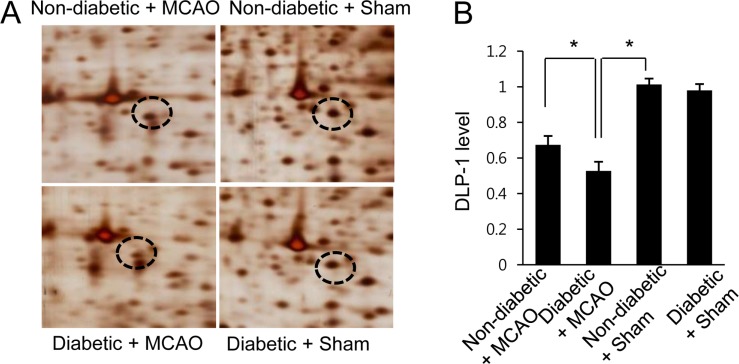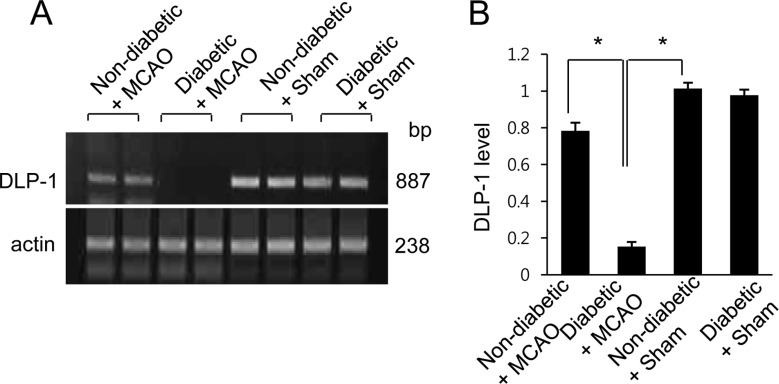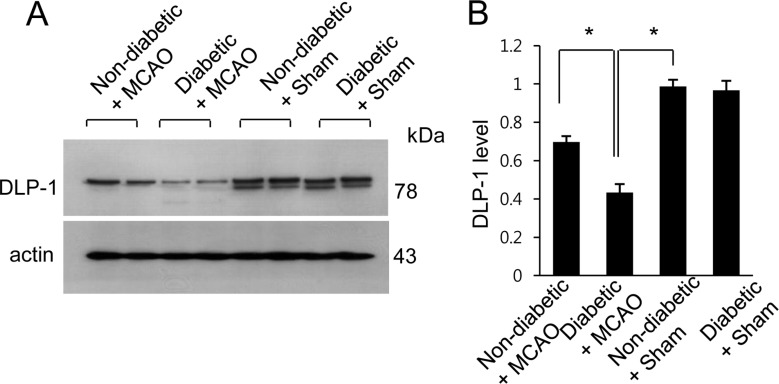Lab Anim Res.
2017 Sep;33(3):202-208. 10.5625/lar.2017.33.3.202.
Hyperglycemia exacerbates downregulation of dynamin-like protein 1 in ischemic cerebral injury
- Affiliations
-
- 1Department of Anatomy, College of Veterinary Medicine, Research Institute of Life Science, Gyeongsang National University, Jinju, Korea. pokoh@gnu.ac.kr
- 2Division of Life Science and Applied Life Science, College of Natural Sciences, Gyeongsang National University, Jinju, Korea.
- KMID: 2391092
- DOI: http://doi.org/10.5625/lar.2017.33.3.202
Abstract
- Ischemic stroke is one of the leading causes of adult disability and death. Hyperglycemia is associated with an increased risk of stroke and poor outcomes after brain injury. Dynamin-like protein I (DLP-1) regulates mitochondrial fission and promotes mitochondrial dynamics. Neurodegenerative diseases are associated with mitochondrial dysfunction, and the downregulation of DLP-1 has been previously identified in a stroke animal model. Here, we investigated the changes in DLP-1 protein expression in an animal model of focal cerebral ischemia with induced hyperglycemia. Streptozotocin (40 mg/kg) was intraperitoneally injected into male rats to induce hyperglycemia, and middle cerebral artery occlusion (MCAO) was surgically induced 4 weeks after streptozotocin treatment. Brain tissue was isolated 24 hours after MCAO, and cerebral cortex samples were used for this study. Proteomics revealed a decrease in DLP-1 expression in MCAO animals when compared with controls, and this downregulation was more prominent in MCAO animals with hyperglycemia. Reverse-transcription polymerase chain reaction and Western blot analyses confirmed that DLP-1 was significantly downregulated in MCAO-injured animals with hyperglycemia compared to those without hyperglycemia. The decrease in DLP-1 indicates mitochondrial morphological changes and dysfunction. Together, these results suggest that the severe decrease of DLP-1 seen after brain injury under hyperglycemic conditions may exacerbate the damage to the brain.
Keyword
MeSH Terms
Figure
Reference
-
1. Siniscalchi A, Gallelli L, Malferrari G, Pirritano D, Serra R, Santangelo E, De Sarro G. Cerebral stroke injury: the role of cytokines and brain inflammation. J Basic Clin Physiol Pharmacol. 2014; 25(2):131–137. PMID: 24515999.
Article2. Doi Y, Ninomiya T, Hata J, Fukuhara M, Yonemoto K, Iwase M, Iida M, Kiyohara Y. Impact of glucose tolerance status on development of ischemic stroke and coronary heart disease in a general Japanese population: the Hisayama study. Stroke. 2010; 41(2):203–209. PMID: 19940278.3. Bruno A, Liebeskind D, Hao Q, Raychev R. UCLA Stroke Investigators. Diabetes mellitus, acute hyperglycemia, and ischemic stroke. Curr Treat Options Neurol. 2010; 12(6):492–503. PMID: 20848328.
Article4. Widmer H, Abiko H, Faden AI, James TL, Weinstein PR. Effects of hyperglycemia on the time course of changes in energy metabolism and pH during global cerebral ischemia and reperfusion in rats: correlation of 1H and 31P NMR spectroscopy with fatty acid and excitatory amino acid levels. J Cereb Blood Flow Metab. 1992; 12(3):456–468. PMID: 1569139.
Article5. Dietrich WD, Alonso O, Busto R. Moderate hyperglycemia worsens acute blood-brain barrier injury after forebrain ischemia in rats. Stroke. 1993; 24(1):111–116. PMID: 8418533.
Article6. Folbergrová J, Memezawa H, Smith ML, Siesjö BK. Focal and perifocal changes in tissue energy state during middle cerebral artery occlusion in normo- and hyperglycemic rats. J Cereb Blood Flow Metab. 1992; 12(1):25–33. PMID: 1727140.
Article7. Gentile NT, Seftchick MW, Huynh T, Kruus LK, Gaughan J. Decreased mortality by normalizing blood glucose after acute ischemic stroke. Acad Emerg Med. 2006; 13(2):174–180. PMID: 16436794.
Article8. Sims NR, Muyderman H. Mitochondria, oxidative metabolism and cell death in stroke. Biochim Biophys Acta. 2010; 1802(1):80–91. PMID: 19751827.
Article9. Starkov AA, Chinopoulos C, Fiskum G. Mitochondrial calcium and oxidative stress as mediators of ischemic brain injury. Cell Calcium. 2004; 36(3-4):257–264. PMID: 15261481.
Article10. Verstreken P, Ly CV, Venken KJ, Koh TW, Zhou Y, Bellen HJ. Synaptic mitochondria are critical for mobilization of reserve pool vesicles at Drosophila neuromuscular junctions. Neuron. 2005; 47(3):365–378. PMID: 16055061.
Article11. Westermann B. Mitochondrial fusion and fission in cell life and death. Nat Rev Mol Cell Biol. 2010; 11(12):872–884. PMID: 21102612.
Article12. Palmer CS, Osellame LD, Stojanovski D, Ryan MT. The regulation of mitochondrial morphology: intricate mechanisms and dynamic machinery. Cell Signal. 2011; 23(10):1534–1545. PMID: 21683788.
Article13. Shirendeb U, Reddy AP, Manczak M, Calkins MJ, Mao P, Tagle DA, Reddy PH. Abnormal mitochondrial dynamics, mitochondrial loss and mutant huntingtin oligomers in Huntington's disease: implications for selective neuronal damage. Hum Mol Genet. 2011; 20(7):1438–1455. PMID: 21257639.
Article14. Swerdlow RH. The neurodegenerative mitochondriopathies. J Alzheimers Dis. 2009; 17(4):737–751. PMID: 19542616.
Article15. Li H, Chen Y, Jones AF, Sanger RH, Collis LP, Flannery R, McNay EC, Yu T, Schwarzenbacher R, Bossy B, Bossy-Wetzel E, Bennett MV, Pypaert M, Hickman JA, Smith PJ, Hardwick JM, Jonas EA. Bcl-xL induces Drp1-dependent synapse formation in cultured hippocampal neurons. Proc Natl Acad Sci U S A. 2008; 105(6):2169–2174. PMID: 18250306.
Article16. Ishihara N, Nomura M, Jofuku A, Kato H, Suzuki SO, Masuda K, Otera H, Nakanishi Y, Nonaka I, Goto Y, Taguchi N, Morinaga H, Maeda M, Takayanagi R, Yokota S, Mihara K. Mitochondrial fission factor Drp1 is essential for embryonic development and synapse formation in mice. Nat Cell Biol. 2009; 11(8):958–966. PMID: 19578372.
Article17. Wakabayashi J, Zhang Z, Wakabayashi N, Tamura Y, Fukaya M, Kensler TW, Iijima M, Sesaki H. The dynamin-related GTPase Drp1 is required for embryonic and brain development in mice. J Cell Biol. 2009; 186(6):805–816. PMID: 19752021.
Article18. Jang AR, Koh PO. Ischemic brain injury decreases dynamin-like protein 1 expression in a middle cerebral artery occlusion animal model and glutamate-exposed HT22 cells. Lab Anim Res. 2016; 32(4):194–199. PMID: 28053612.
Article19. Longa EZ, Weinstein PR, Carlson S, Cummins R. Reversible middle cerebral artery occlusion without craniectomy in rats. Stroke. 1989; 20(1):84–91. PMID: 2643202.
Article20. Jeon SJ, Sung JH, Koh PO. Hyperglycemia decreases expression of 14-3-3 proteins in an animal model of stroke. Neurosci Lett. 2016; 626:13–18. PMID: 27177727.
Article21. Li ZG, Britton M, Sima AA, Dunbar JC. Diabetes enhances apoptosis induced by cerebral ischemia. Life Sci. 2004; 76(3):249–262. PMID: 15531378.
Article22. Rizk NN, Rafols J, Dunbar JC. Cerebral ischemia induced apoptosis and necrosis in normal and diabetic rats. Brain Res. 2005; 1053(1-2):1–9. PMID: 16038884.
Article23. Low PA, Lagerlund TD, McManis PG. Nerve blood flow and oxygen delivery in normal, diabetic, and ischemic neuropathy. Int Rev Neurobiol. 1989; 31:355–438. PMID: 2557297.
Article24. Russell JW, Sullivan KA, Windebank AJ, Herrmann DN, Feldman EL. Neurons undergo apoptosis in animal and cell culture models of diabetes. Neurobiol Dis. 1999; 6(5):347–363. PMID: 10527803.
Article25. Cameron NE, Cotter MA. Effects of evening primrose oil treatment on sciatic nerve blood flow and endoneurial oxygen tension in streptozotocin-diabetic rats. Acta Diabetol. 1994; 31(4):220–225. PMID: 7888693.
Article26. Yu T, Robotham JL, Yoon Y. Increased production of reactive oxygen species in hyperglycemic conditions requires dynamic change of mitochondrial morphology. Proc Natl Acad Sci U S A. 2006; 103(8):2653–2658. PMID: 16477035.
Article27. Pitts KR, Yoon Y, Krueger EW, McNiven MA. The dynamin-like protein DLP1 is essential for normal distribution and morphology of the endoplasmic reticulum and mitochondria in mammalian cells. Mol Biol Cell. 1999; 10(12):4403–4417. PMID: 10588666.
Article28. Smirnova E, Shurland DL, Ryazantsev SN, van der Bliek AM. A human dynamin-related protein controls the distribution of mitochondria. J Cell Biol. 1998; 143(2):351–358. PMID: 9786947.
Article29. Chen H, Chan DC. Mitochondrial dynamics--fusion, fission, movement, and mitophagy--in neurodegenerative diseases. Hum Mol Genet. 2009; 18:R169–R176. PMID: 19808793.
Article30. Ding C, He Q, Li PA. Activation of cell death pathway after a brief period of global ischemia in diabetic and non-diabetic animals. Exp Neurol. 2004; 188(2):421–429. PMID: 15246841.
Article31. Muranyi M, Fujioka M, He Q, Han A, Yong G, Csiszar K, Li PA. Diabetes activates cell death pathway after transient focal cerebral ischemia. Diabetes. 2003; 52(2):481–486. PMID: 12540624.
Article32. Muranyi M, Ding C, He Q, Lin Y, Li PA. Streptozotocin-induced diabetes causes astrocyte death after ischemia and reperfusion injury. Diabetes. 2006; 55(2):349–355. PMID: 16443767.
Article33. Tiwari BS, Belenghi B, Levine A. Oxidative stress increased respiration and generation of reactive oxygen species, resulting in ATP depletion, opening of mitochondrial permeability transition, and programmed cell death. Plant Physiol. 2002; 128(4):1271–1281. PMID: 11950976.
Article
- Full Text Links
- Actions
-
Cited
- CITED
-
- Close
- Share
- Similar articles
-
- Ischemic brain injury decreases dynamin-like protein 1 expression in a middle cerebral artery occlusion animal model and glutamate-exposed HT22 cells
- Effect of Hyperglycemia in Cerebrovascular Disease
- Upregulation of miR-20b Protects Against Cerebral Ischemic Stroke by Targeting Thioredoxin Interacting Protein (TXNIP)
- Analysis of Spatial and Temporal Protein Expression in the Cerebral Cortex after Ischemia-Reperfusion Injury
- Childhood Ischemic Stroke Associated with Protein S Deficiency: A case report




